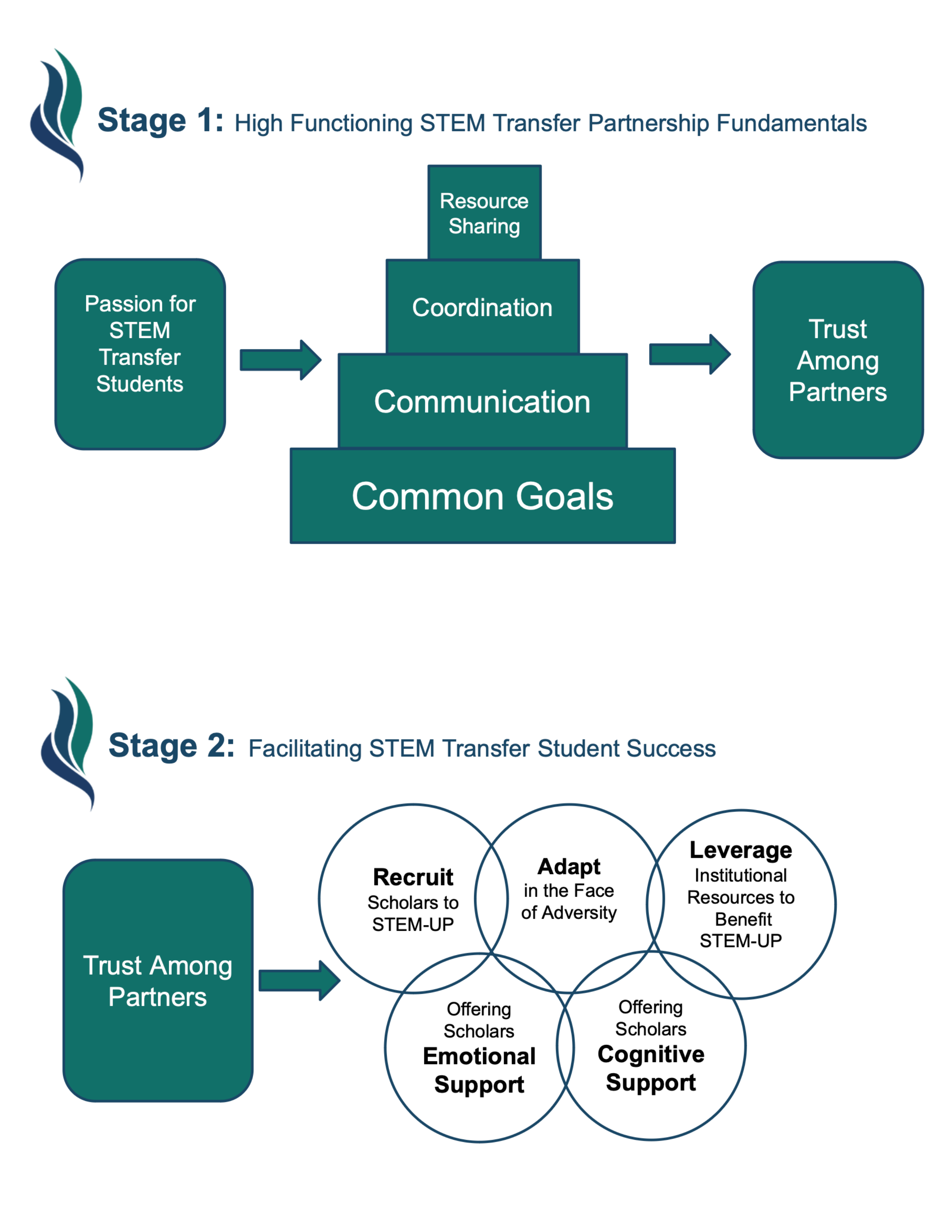
Spring greetings from PROSPECT S-STEM! We want to reiterate how appreciative we are of everyone who has participated in a PROSPECT S-STEM case study site visit, from helping to make arrangements to participating in interviews to analyzing the data. We wanted to share some preliminary research that the research team* is working on, related to the hidden work entailed in developing and sustaining partnerships across institutions (i.e., the work all of you are doing!).
Hidden work refers to work that is essential but essentially unrecognized; this concept has different names in different fields (such as business, education), and we specifically draw on with strategic partnership work by Amey, Eddy, & Cambell (2010) and on centering equity in transfer relationships (Crisp, Kolby, & Potter, 2022).
Dr. Marilyn Amey and colleagues research describing how institutional partnerships become sustainable, recently grabbed PROSPECT researchers’ attention. Maintaining S-STEM partnerships is hard work, but can it also be thought of as hidden work? If so, what is the nature of the hidden work needed to support co-equitable S-STEM partnerships?
We recently gave a presentation about this at a symposium at the University of Missouri Kansas City which centered on the research question: What is the nature of hidden work underlying a successful Community College/University STEM transfer program? We did some open coding on a small subset of interviews to look for instances of different types of hidden work. We also engaged in a poetic transcription (Glesne, 1997; Tremaine & Hagman, 2023) of the relationship/relational codes.
Poetic transcription is a poem that uses words and phrases from the interview transcripts to convey both ideas and emotions. In this case, the poetic transcription focused on how the partnership built up and leverages trust across partners. If you would like to experience the poem, here is a recording.
We’re finding that (unsurprisingly) there is a lot of hidden work that goes into S-STEM partnerships. We have heard people talk about a common passion for supporting STEM transfer students, and partnerships that feature resource sharing, coordination, communication, and common goals. Such partnership features lead to trust among partners as part of a high functioning STEM transfer partnership.
The types of hidden work that we saw people talk about to facilitate STEM transfer student success can be grouped into five major categories: Recruiting scholars; Adapting in the face of adversity; Leveraging institutional resources to benefit the S-STEM project; Emotional Support for Scholars; and Cognitive Support for Scholars. You may well recognize some of these categories as including work that you do to support your local S-STEM success.
Hidden work often is viewed as “normal” in academia, but there are serious issues with allowing such work to remain unrecognized. Some questions you might want to discuss with your local S-STEM partners:
1) What hidden work is supporting our partnership? Who takes on the majority of hidden work?
2) What happens if partners are unable and/or unwilling to undertake hidden work?
3)When hidden work is undertaken, what are the likely effects of hidden worker burnout?
4) When the funding ends, how likely is it that successful transfer partnerships can be sustained, while depending on unpaid hidden work?
5) How can we shine light on and recognize the hidden work to make it visible? How can people get credit for engaging in the relational work of sustaining partnerships?
We encourage you to have conversations locally and commit to making hidden work visible and valued. This is just one small dimension of the rich data we have collected from all of your S-STEM projects; your participation is helping us to inform the field and improve the culture related to supporting STEM transfer students.
*Many people are engaging in the work of PROSPECT S-STEM research; those who have contributed most to this analysis of hidden work include Dr. Michelle Maher (UMKC), Megan Hickey (UMKC), Dr. Wendy Smith (UNL), Dr. Mindi Searls (UNL), Katie Johnson (UNL), and Camilla Ramos de Matos Carvalho Morone (UNL).
References
Amey, M. J., & Eddy, P. L. (2014). Creating strategic partnerships: A guide for educational institutions and their partners. Routledge.
Crain, M. G., Poster, W., & Cherry, M. A. (2016). Invisible labor: Hidden work in the contemporary world. University of California Press. https://doi.org/10.1525/9780520961630
Crisp, C. Kolby, E. B., & Potter, C. (2022). Centering equity in transfer relationships. Journal of College Orientation, Transition, and Retention, 29(2). https://doi.org/10.24926/jcotr.v29i2.4629
Glesne, C. (1997). That rare feeling: Re-presenting research through poetic transcription. Qualitative Inquiry, 3(2), 202–221. https://doi.org/10.1177/10778004970030020
Tremaine, R. & Hagman, J. E. (2023). Creativity and Subjectivity: Two Researchers’ Poetic Re-Presentations of Critical Student Perspectives of Mathematical Success. In S. Cook, B. Katz, & D. Moore-Russo (Eds.), Proceedings of the 25th Annual Conference on Research on Undergraduate Mathematics Education (pp. 1117-1124), Omaha, Nebraska.